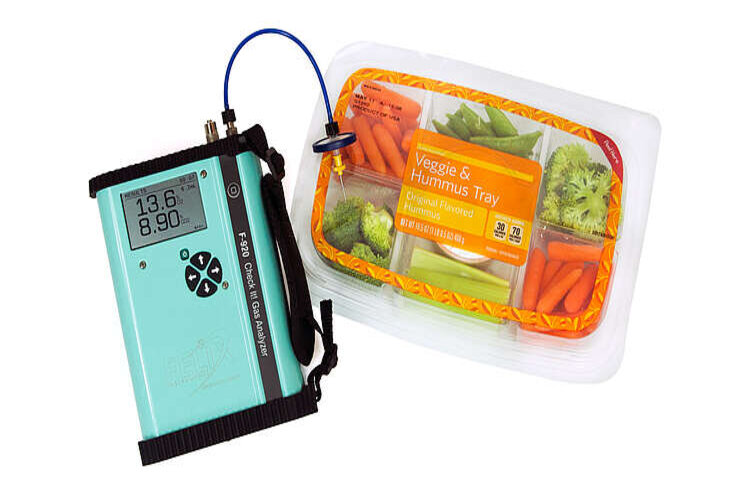Instruments for pre-harvest and post-harvest gas analysis
Added on 10 November 2020


Three gases, oxygen (O2), carbon dioxide (CO2), and ethylene (C2H4) are involved in crucial physiological processes. Tracking gas concentrations to maintain them at optimum levels boosts crop growth, product yield, and quality, as well as extends post-harvest storage. The critical level for each gas varies based on their respective roles at different stages of the supply chain.
Pre-Harvest Gas Analysis
For crops grown in greenhouses, vertical farms, or aeroponics, carbon dioxide and oxygen are monitored throughout the crop period.
Plants use carbon dioxide, absorbed through leaves, in photosynthesis to produce simple sugars, which form the basis of all compounds found in plants. Moreover, as fruits develop and mature, they accumulate sugars, making total soluble sugars and dry matter content important quality parameters.
CO2 levels, which decrease during the day due to photosynthesis, must be monitored to maintain a minimum of 280-340 parts per million (ppm). At lower levels, CO2 is supplemented with carbon fertilization or by ventilating the room. Some growers increase CO2 up to 1000 ppm to increase crop productivity and quality, depending on the crop and growth stage, temperature, and light intensity.

All fruit and vegetable crops need oxygen. Ventilation provides adequate oxygen for shoots. However, ground oxygen levels can fall due to a rise in temperature and increased irrigation. Levels below 2 ppm affect root growth and the health of the whole plant.
Post-Harvest Gas Analysis
During storage, transport, and retailing, all three gases must be monitored, see Figure 1.

Figure 1: Respiration and ethylene production in different plant phases in climacteric and non-climacteric fruits, Paul et al. 2011. (Image credits: https://www.mdpi.com/1424-8220/19/2/372/htm#B5-sensors-19-00372)
Carbon Dioxide
Postharvest, the levels of carbon dioxide should be below 1 to 5% by volume to prevent irregular ripening, fruit decay, and production of undesirable odors, depending on the commodity.
Oxygen
Fruits continue to respire, even after they are picked, using accumulated sugars and reducing fruit quality. Therefore, oxygen levels should be below 5% in post-harvest stages (again, specific level is dependent on commodity), but should not reach zero. The complete absence of oxygen causes anaerobic fermentation which leads to fruit decay.
Ethylene
Though plants start to produce ethylene from germination, its main role is during ripening in the post-harvest stages (Figure 1).
Climacteric fruits produce ethylene at maturity, and many non-climacteric fruits are sensitive to ethylene. Hence, cold storage and controlled atmosphere storage aim to create conditions that control ethylene levels. The levels of ethylene can vary from 10-100 ppm depending on temperature, as well as oxygen and carbon dioxide concentrations. Ethylene scrubbing can be used to reduce ethylene levels. When fruit is needed for retailing, the ethylene supply is increased to induce ripening.

Gas Analysis Devices
There are many precision instruments supplied by Fresh Produce Instruments which are designed to suit these supply chain needs. In all the devices, levels of O2 and CO2 are measured from 0-100%. It is the range of ethylene and its measurement resolution that differs between the tools based on their intended function. Four of these tools are:
- F-940 Store it! Gas Analyzer - For use during storage. Measured ethylene range, from 0-10 ppm.
- F-950 Three Gas Analyzer - For use throughout the supply chain. Measured ethylene range, from 0-200 ppm.
- F-960 Ripen it! Gas Analyzer - For use within or outside the ripening room. Measured ethylene range, from 0-1000 ppm.
- F-920 Check it! Gas Analyzer - Measures O2 and CO2 and is useful for pre-harvest operations, analysis of headspace, and Modified Atmosphere Packaging (MAP).
Increase Production and Profits
These tools from Felix Instruments measure gases simultaneously, making the task of monitoring and controlling gas levels hassle-free. The devices are rapid and user-friendly, requiring little to no training to use. Gas analysis can play an important role in increasing profits by preventing food loss, extending storage time, and preserving fruit quality.
About Fresh Produce Instruments
Fresh Produce Instruments exists to help the fresh produce industry monitor, maintain, and improve the quality of their fresh produce by the sale and service of technical instruments aimed at addressing the measurement and control of parameters that dictate quality.
Contact:
Anna Zegveld
Fresh Produce Instruments
+31850601835
az@freshproduceinstruments.com
Source: Goedemorgen
More news















